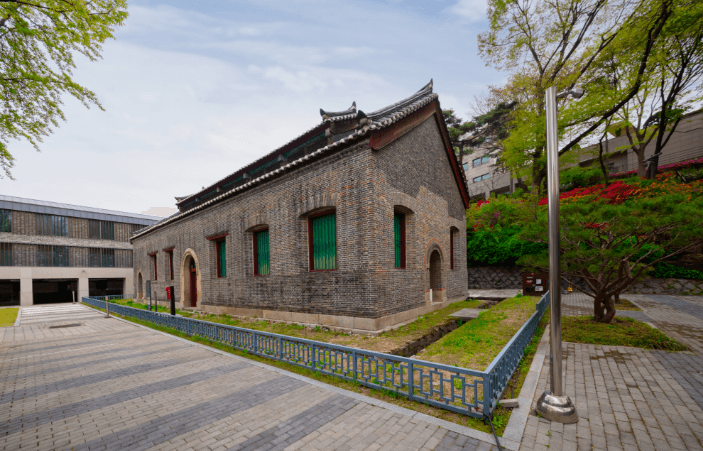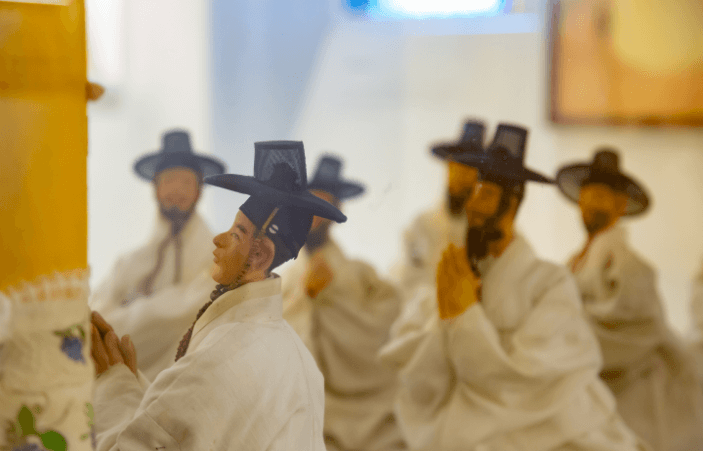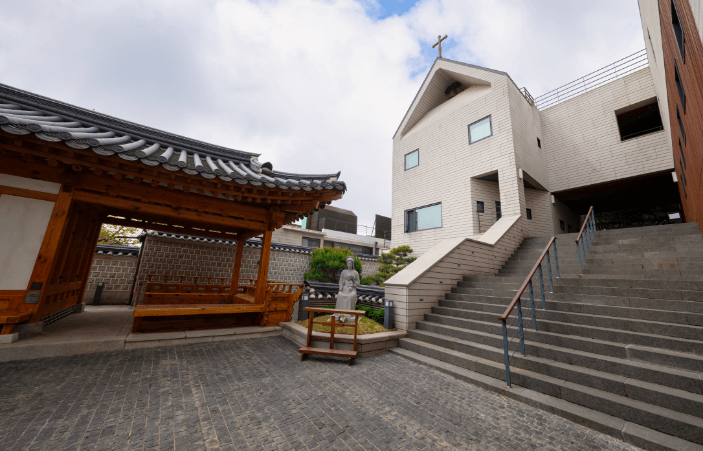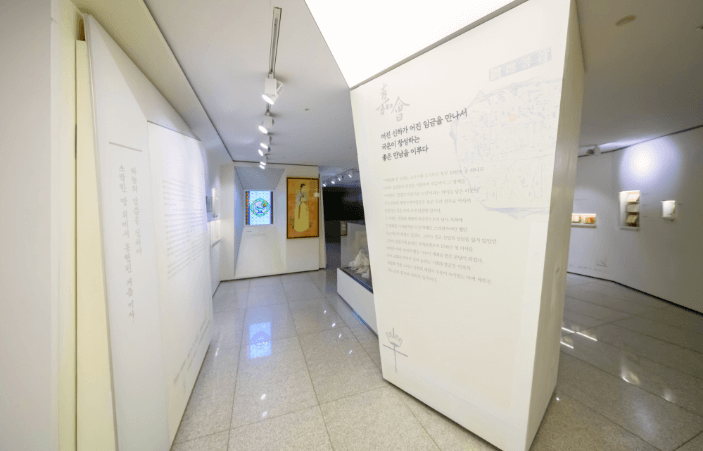How about a neighborhood that bridges the traditions of 500-year-old Joseon with contemporary Korea? Bukchon, with its exciting juxtaposition of modern buildings and alleyways, hides traces of both the Joseon era and modern times. Explore the deep-seated intentions and significance of old Korea between the architecture of Joseon's iconic palaces and the forward-looking buildings of the contemporary era.
* Walking Standard

After Korea opened to the world at the end of the Joseon dynasty, King Gojong strived to modernize the nation, and military facilities saw the most significant transformation. The Joseon government, eager to protect its citizens, sent envoys to Japan and Qing China to learn about advanced Western technology and culture. When they returned, they established Beonsachang, a factory for producing new weaponry. Of the five buildings that made up this factory, only the ammunition and weapon storage building remain today.
This architectural blend of Eastern and Western styles that combines Chinese-style bricks with a traditional Korean roof, is unique and historically significant. The factory is the nation's first modern weaponry manufacturing site and embodies turn-of-the-century Korea’s aspirations to protect the country. Please note that access inside the building may be restricted.
- Address 118, Samcheong-ro, Jongno-gu, Seoul
- Inquiry 02-3700-1500
Gahoe-dong Cathedral is historically significant as the first church in the history of Korean Catholicism where the inaugural Mass was celebrated, and it still retains traces of persecution. The original cathedral, built in 1949, was rebuilt in February 2010 by Father Song Cha-seon (John the Baptist), an architecture graduate. ”It is characterized by a harmonious blend of a traditional hanok Sarangchae (guest room) and a modern cathedral structure. The rationale for the modest hanok facing the street with the priest's quarters and altar concealed within was to echo the discreet design of the original church, where Masses were held in secret during times of persecution. The serene atmosphere of the main hall on the second floor is accentuated by the sunlight filtered through the windows and the warm, earth-toned wooden walls.
In accordance with Father Song's wish to create a welcoming space for everyone, the entrance threshold was eliminated so that visitors of all backgrounds, regardless of their religion, could enter freely. However, please note that the cathedral is closed to the public on Mondays and public holidays.
- Address 57, Bukchon-ro, Jongno-gu, Seoul
- Inquiry 02-763-1570
The LG Sangnam Library is South Korea's pioneering “digital library” and the world's first “Library that Reads Books to You.” It was established in 1996 on the grounds of the private residence donated by LG Group founder, Honorary Chairman Koo Cha-kyung. The library was created as a beacon to advance the nation's scientific and technological research while supplying related materials. Foreign scientific and technical papers, which are challenging to procure domestically, are digitalized and offered free of charge online. The seminar room on the second floor is also available for rent at no cost as a venue for small-scale academic gatherings in the fields of science and technology. Reservations for the seminar room can be made through their website, so it is an excellent place for those interested in science and technology to review and discuss the latest research papers.
The “Library that Reads Books to You” was designed by architect Kim Soo-geun and was established to commemorate the 10th anniversary of the LG Sangnam Library. For the visually impaired, an assortment of more than 50 new books, including new releases, bestsellers, newspaper articles and movie scripts, are offered in audio form free of charge every month. After applying for a library membership and receiving authentication with a welfare card, users can access the library from anywhere with their mobile devices and listen to the content of the books. Since the facility exclusively serves the disabled as a free electronic library, general public access is restricted, and interior tours are not available.
- Address 18, Changdeokgung 1-gil, Jongno-gu, Seoul
- Inquiry 02-708-3700
Designed to be in harmony with nearby Changdeokgung Palace and the surrounding traditional houses, the Arario Museum is reminiscent of conventional Korean grain storage structures built using round stones. While its façade is decorated with green ivy to promote coexistence with nature, the interior, with the structure of a traditional Korean house, is open and interconnected. The architectural philosophy of “symbiosis” championed by architect Kim Soo-geun is evident here, as the building preserves the natural slope of the terrain. Its skip-floor design maximizes spatial perception and blurs the boundaries between floors, making it feel like a labyrinth. Contemporary artworks not limited to nationality or genre have different interpretations depending on the visitor’s viewpoint. To genuinely appreciate it, an in-person visit is recommended. However, due to space constraints and potential hazards, entrance is restricted for children under 10.
- Address 83, Yulgok-ro, Jongno-gu, Seoul
- Inquiry 02-736-5700
To understand the beginning of the March 1st Movement, the most significant independence movement in the nation, you must visit the Cheondogyo Central Church. Built in 1918 and completed in 1921, this main hall of Cheondogyo has served as a site for religious ceremonies and a historical venue for various political rallies and artistic performances.
Its majestic façade, with a Baroque-inspired roof and red brick structure, was once counted among Seoul's top three architectural marvels along with Myeongdong Cathedral and the Chosun Governor-General Building. While its construction was officially intended to raise funds for the independence movement, a portion of these funds supported the core activities of the March 1st Movement. The architectural style is rare in modern Korean architecture and exhibits segmented arch influences, and is believed to have been inspired by a German architect. The structure was mainly built using granite and lacks internal columns, and is complemented by an auditorium-style assembly hall.
The Cheondogyo Central Church echoed the sentiments of the public in turbulent times and was both a civilian council and the epicenter of national movements. It remains a living testament to Korea’s recent history where you can feel the genuine desires and unyielding will of countless souls for independence.
- Address 57, Samildae-ro, Jongno-gu, Seoul
- Inquiry 02-735-7579

한국관광공사가 창작한 본 저작물은 공공누리 제4유형 조건에 따라 이용이 가능합니다.
한국관광공사에 의해 창작된 [청와대 코스 ③] 선조들의 의지가 담긴 북촌 공간 여행은 공공라이선스에 따라 이용할 수 있습니다. 사진 자료의 경우, 피사체에 대한 명예훼손 및 인격권 침해 등 일반 정서에 반하는 용도의 사용 및 기업 CI, BI로의 이용을 금지하며, 상기 지침을 준수하지 않음으로 인해 발생하는 이용자와 제3자간 분쟁에 대해서 한국관광공사는 책임을 지지 않습니다.



















